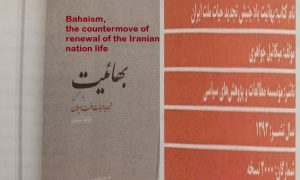The book “Bahaism, the countermove of renewal of the Iranian nation life” has been written by Michael Jawaheri published by the political research and studies institute. The publishing house where is publishing remarkable works concerning the important transformation of the contemporary history of Iran. The generality of political, historical and research book is concerning about three cults of the contemporary history of Iran called Sheikism, Babism and Bahaism. In this work, the Persian speaking addressees become familiar with the leaders of these cults’ lives, belief fates and works comprehensively based on historical documents. This issue is important because the role of Colonial Britain in creating and helping these cults to be preached is going to be clear for the addressees.
In chapter 9 of the book, the topics like “Times and backgrounds”, “Sheikism”, “Babism”, “A review of Bahaism”,” Colonialism, Babism and Bahaism”, “The Baha’is and Reza Shah Pahlavi’s government”, “reactions”, “Imam Khomeini’s (P.H.) campaign against Bahaism” have been analyzed and investigated.
In the first chapter, the author has analyzed the origins of three movements of Sheikism, Babism and Bahaism intellectually. They were made subsequently during Fath Ali Shah’s period of time historically.
In second and third chapters, the superstitious thoughts and exaggerative views of Sheik Ahmad Ehsaee, the leader of Sheikism cult have been investigated. Also, the method of Ahmad Elsaee’s pupils such as Seyyed Kazem Rashti in avoiding rationalism is introduced and the addressee will figure out that how a person called Ali Muhammad Shirazi introduced him as the gate for Imam of the Time (P.M.), but later on he claimed for prophethood and divinity to deviate naive people supported by Colonial Britain.
The 4th chapter of the book is reviewing how Bahaism formed in general. The reader becomes familiar with a young man called Yahya Sobhi Azal whose brother Hussein Ali Nouri hustled him after Ali Muhammad Shirazi’s death and claimed for being a new prophet and introduced a new faith called Bahaism.
Chapters 6 and 7, the names of famous characters related to Bahaism during first and second Pahlavi are being mentioned.
In chapter 8, reactions, the names of those who confronted and campaigned against the deviant cult of Bahaism are mentioned.
Generally speaking, the important feature of the book is explaining historical events in the form of a consistent collection in an important part of the contemporary history as the background for deviant movements during Qajar and Pahlavi periods of time. It is also shown in the book how Baha’ism could be influential in all government pillars during the first and second Pahlavi time.
Additionally, the other advantage of the book is that Imam Khomeini‘s (P.H.) campaigns against the Baha’is during the years 1322 until the victory of the Islamic Revolution have been paid attention.
The book is recommended to readers who are interested in being familiar with cults, the factors of their emergence and the tendency towards cults.






